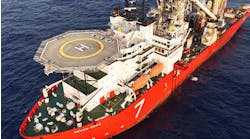Offshore energy builds a better world
Over the past year, pandemic-related lockdowns and lower oil prices delivered a one-two punch to the American offshore market. But the offshore energy industry has weathered these unprecedented challenges and continues to deliver energy while maintaining world-class environmental performance. The resilience of the offshore industry should be applauded, and our elected officials and policymakers should take note of the benefits it creates for the American economy.
As COVID-19 cases repeatedly hit new highs over the past year, the offshore oil and gas industry in the US Gulf of Mexico maintained safe operations. Reflecting a hyper-focus on safety, our industry-wide coordinated action mitigated the spread of COVID-19 early on in the pandemic. Offshore companies and regulators quickly developed and shared best practices on mitigation measures to prevent the spread of COVID-19 in the confined spaces that predominate offshore facilities.
The leadership and initiative showed by the industry during 2020 helped inject purpose and clarity into an incredibly uncertain time. Not only did Gulf of Mexico oil and gas production operations keep energy flowing in a safe manner, but we also provided hydrocarbons and the molecular building blocks that are essential for the medicines, face masks, surgical gowns, and other medical equipment needed during the pandemic.
The response by the industry to COVID-19 is just one example of how our industry is dedicated to safely producing the reliable energy that lifts society, reduces poverty and hunger, and improves health and well-being.
There is still a need for affordable energy in the US and throughout much of the world. A recent study by the EIA found that in 2015, some 25 million American households skipped buying food or medicine in order to pay for energy. Even more shockingly, seven million Americans reported that they skip food or medicine every month to meet their energy costs. Low-income families spend close to three times more on energy than higher income families.
Elsewhere in the world, nearly one billion people still have no access to electricity and three billion people depend on biomass for their heating and cooking. Not only does the lack of modern energy perpetuate substandard living conditions, it also limits economic opportunities and widens the wealth gap in communities around the world.
Oil and natural gas production power our modern lives. Computers and smartphones, sports equipment, fertilizers, cars, medicine, latex, prosthetic limbs, MRI machines and more are made from oil and natural gas products. Modern life simply would not exist without these resources.
We know that technology and innovation define our industry. Technology informs innumerable decisions and offshore operations that seemed impossible a generation ago. New, non-metallic materials and polymers lower costs while reducing component fatigue rates. Remote sensing and real-time monitoring allow offshore and onshore staff to gather and deliver precise data instantly. Drones and ROVs are growing in sophistication and in the detail of data they provide. Artificial intelligence (AI) and machine learning allow computer systems to learn from and interpret data without human input. New AI implementation enables personnel to anticipate and respond quickly to concerns that human operators may not have been able to detect. Digital technology is completely transforming the offshore energy industry.
The Gulf of Mexico oil and gas industry represents a technological marvel, and offshore production can be the energy anchor that the world needs. Multi-billion-dollar offshore projects produce massive amounts of oil and natural gas to meet demand for decades. Advances in technology are enabling offshore fields to produce even more oil and gas, for longer periods of time. New seismic technology and smarter subsea tiebacks and other infrastructure are opening the door to a new era of productivity and efficiency.
Offshore progress means our industry can be a source of stability and optimism as the world strives to solve climate and emission challenges. The offshore industry produces a vast amount of energy with an incredibly small environmental footprint, with low emissions. For example, energy production in the Gulf of Mexico averages half the carbon intensity of other producing regions. Deepwater production, which accounts for 92% of Gulf of Mexico production, has the lowest greenhouse gas emissions of all types of oil sources. Production occurs miles from onshore population areas, allowing operations to be far removed from traditional fence line issues.
Importantly, the Gulf of Mexico is helping progress a new era of the offshore: renewable wind energy. The same companies that built the Gulf of Mexico oil and gas industry are lending their experience to build out wind projects along the Atlantic Coast. Offshore wind offers a generational energy and economic opportunity.
Wood Mackenzie conducted a study on how striking the wind opportunity opportunities are for Americans. Just four lease opportunities, offshore New York, the Carolinas, Maine and California, could generate 28 new gigawatts of clean energy and $1.7 billion in US Treasury revenue by 2022. To build up these windfarms, the industry would support more than 80,000 annual jobs and generate $166 billion in investment by 2035.
Policymakers should recognize what our industry is achieving in the Gulf of Mexico, and work with us to build even greater achievements. The offshore industry is unique in how we can provide energy safely, reliably and sustainably at such a large scale.
I am proud to be part of the offshore industry. Every day we are building a better world.
The author
Galen Cobb is the Vice President of Industry Relations for Halliburton and Chairman of the National Ocean Industries Association (NOIA).



